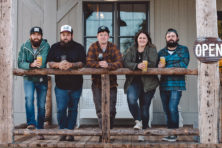Door County’s Female Founders
- Share
- Tweet
- Pin
- Share
Half of Door County’s history has been mostly ignored, if not forgotten. It’s been told through the tales of the founding fathers, the men who first settled, built churches and schools.
Those men weren’t alone. They had wives and daughters who helped build, farm, raise children and make a life. But those women get little recognition in our history books.
That’s why flipping the pages of Door County history books made Kärin Kopischke angry.
“Everything I read mentioned the men’s names,” Kopischke said. “It would be the man’s first name, his middle name, his last name, and then he had ‘a wife.’ She had 10 children that were all born in Door County and they didn’t even get the wife’s name.”
Kopischke, a costume design professor at Lawrence University, decided it was time to give those women the credit they deserve. She began working on a project called Garments of our Foundation, and with the help of Patti Podgers and Paul Burton, created exhibits of tales of founding women in Gibraltar, Ephraim and Sister Bay.
Podgers and Burton wrote first-person narratives based on information found after digging through dusty books, old newspapers and ancestry.com. Kopischke put together portraits of the women with strips of fabric from the time period.
“I wanted to choose women that really were important in the founding of Door County, but I also was attracted to the women that seemed to have very specific struggles and challenges,” Kopischke said.
She sought out diversity – a Potawatomi woman, one pregnant out of wedlock, a child bride. Much of what they experienced would be difficult to handle today, 100 years later.
“It’s always that story of the woman standing behind her man,” Podgers said. “There were many women who stepped forward to stand alongside their men. Those are the stories that we worked on.”
Podgers has long been a feminist. She was a young teacher in the early ‘70s, right on the midst of a renewed women’s movement.
In her time as a historian in Door County, Podgers has worked at the Noble House, the Door County Auditorium and is currently the curator and manager of the Eagle Bluff Lighthouse Museum. When Kopischke approached her with the opportunity to tell the story of Sister Bay and Gibraltar’s forgotten, nameless women, she was enthused.
“I fell in love with these women for different reasons,” Podgers said. “I didn’t see myself necessarily in them, but I saw the mothers, the sisters, the daughters who came before… These are the women who forged the path through the woods, who rode on the wagons over dirt roads, who traversed open prairies and cut their way through the forest.”
Kopischke, Podgers and Burton couldn’t say why women are often ignored in most history books, but agreed that women deserve more recognition in future history accounts.
“It has been a man’s world,” Burton said. “Things are really changing and that’s for the better. In the old days the men called the shots.”
They agreed it’s important to weave women’s stories into history, that we acknowledge the names and actions of the women who settled Door County.
“I think it’s very important we remember the heritage, the legacy that the women gave us, not just the men,” Podgers said. “The women who gave birth, who died, who were buried without their names on their grave markers. Maybe our girls will learn from it. Maybe our boys will be more appreciative of the women.”
Read about some of the women featured in Garments of our Foundation:


